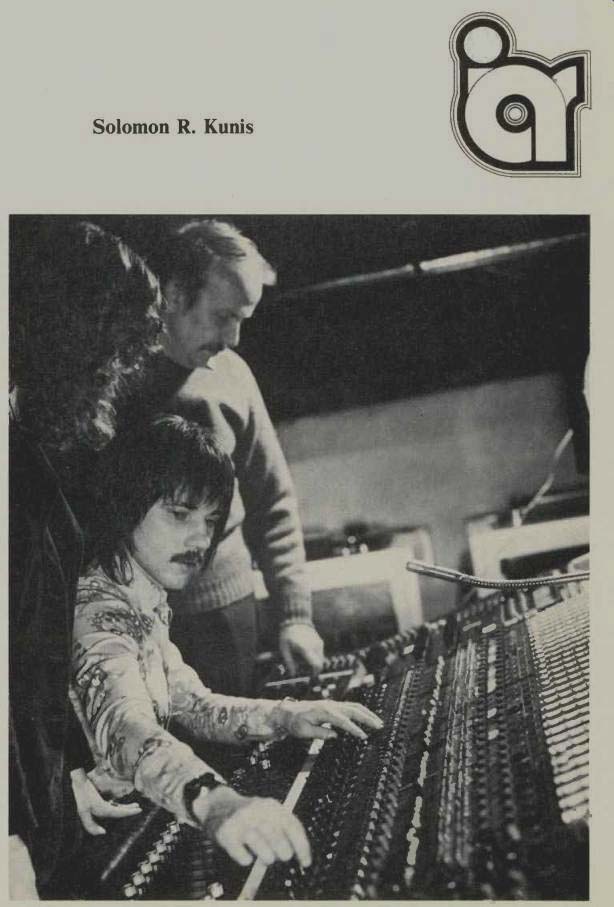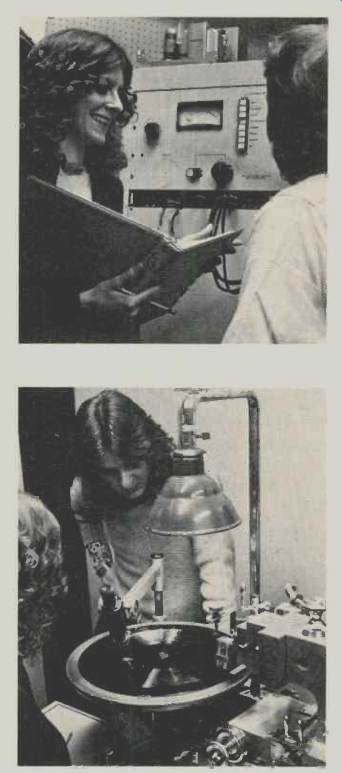
----- Electric Lady's Chief Engineer Dave Palmer demonstrates the operation
of the Studio A Console to Suzanne Lanier and IAR Director Al Grundy.
by Solomon R. Kunis
SELF-TAUGHT recording engineers, who learned their trade at the mixing console without benefit of classroom, are a vanishing breed, says Albert B. Grundy, Director of the Institute of Audio Research (IAR). They will be gradually replaced by younger men and women who have mastered the fundamentals of audio engineering either at a college or a technical school like the Institute which Al heads.
The JAR, located at 64 University Place, New York City, was founded by Grundy and his partner Irwin J. Diehl in 1969 to train studio engineers. The school is regarded as the first and one of the best specifically organized to provide students with the technological foundation required in today's sound studio.
During its five-year history, the Institute has attracted students ranging in age from their early twenties to mid forties. Many are newcomers seeking recording jobs, while some are already studio employees and wish to enlarge their knowledge of audio techniques.
The school also serves a number of people each term who have less immediate vocational needs. These include hi-fi enthusiasts, musicians, and studio executives, who are primarily concerned with improving their understanding and appreciation of the sound recording process.
Institute alumni hold down studio jobs all over the United States and Canada-as well as overseas in England and in Israel. One of the graduates supervised the recording of Bob Dylan's latest album, Planet Waves, and served as sound engineer on Dylan's recent concert tour. Another now owns and operates his own 16-track recording studio, while a third runs a record company and is highly involved with disc production.
The Institute has several women students each term. One recent graduate, Carla Bandini, is now employed at CBS Records in London. Suzanne Lanier, who migrated from Florida to attend the school last fall, obtained a studio job before graduation, and has since worked with hit record producer Todd Rundgren.
Between 60 and 80 students are enrolled each semester in one or more of the courses. The basic course, Studio Technology and Practice, is a 10-week, 60-hour evening laboratory/lecture class which covers recording fundamentals, magnetic recording, studio consoles, and signal processing equipment. In addition to classroom work, there are field trips to modern recording studios where students may observe the most advanced equipment and techniques in actual operation.
The class in Practical Disc Recording, also given at night, is a five-week, 40-hour workshop training course. The students work with live equipment, including a Scully lathe with Ortofon cutting head, to further their knowledge of vinyl records, disc-cutting lathes, recording blanks, and lathe layout, operation and maintenance.
The Institute also conducts a seminar in Audio Systems Design. This brief but intensive 4-day course covers in depth most aspects of the electrical design of studio systems. Considered in detail are topics of gain, loss and impedance interface to achieve maximum S/N and minimum distortion.
And recently, a new seminar, Digital Logic Design, has been developed and was first introduced in the Spring, 1974 term.

-------- (Top) In front of the disc recording control panel, Suzanne
Lanier discusses a problem with IAR Director Al Grundy. (Middle) Student
David Smith studies the intricacies of a Scully lathe. (Bottom) John Woram,
Director of Special Projects for IAR, instructs professionals seeking to
expand their knowledge of advanced techniques during a four day Producers/Arrangers
Workshop.
The above courses are repeated three times a year. The Fall term begins in September, the Winter term in January, and the Spring term in April. Accelerated classes are also held during the Summer.
The course in Studio Technology and Practice is also given at the Institute's Los Angeles branch in May and October. Classes meet five times a week, and both morning and evening sessions are provided.
The training courses are primarily conducted by Al Grundy, who is the Director of the Institute and presently serves as Chairman of the New York Chapter of the Audio Engineering Society. Grundy, Who obtained his bachelor's degree in electrical engineering from Columbia University, learned his trade at Columbia Electronics Research Laboratory. He virtually grew up with the recording industry and had designed and set up recording studios throughout the United States and in Europe.
"Years ago when the typical recording engineer entered the audio field, life and recording techniques were both a lot simpler." Grundy remembers. "What those old timers lacked in technical know-how, they made up for by adaptability and willingness to learn. The typical studio in those days was equipped with relatively simple equipment, which hardly required a genius to master and understand.
"Today, a kid walks into a studio fully equipped for multi-track recording. He is confronted with 24-channel tape recorders, synchronizing equipment, reverberation and echo systems, limiting amplifiers, and a plethora of other electronic wonders which makes his head swim. Unless he has acquired the fundamental knowledge to make sense of this mass of hardware, he might just as well walk right out again. There is simply no way he can understand how the equipment functions, and his immediate boss will be too busy with his own problems to teach the neophyte Ohm's law." The administrative and physical operations of the Institute of Audio Research are handled by Irwin J. Diehl, a former professional musician who received a degree in Fine Arts from the Cincinnati Conservatory of Music. Before founding the Institute with Grundy, Irv Diehl headed up the studio operations at Caedmon Records and had previously been employed as a staff engineer at Bell Sound Studios.
As co-founder of the IAR, Diehl is deeply concerned with the Institute's integrity and its reputation in the audio field. Irv makes it clear to his students that there is no guaranteed studio job waiting for them at the end of a ten week course, but IAR has excellent rapport with all the major studios in the New York, area and frequently recommends graduates for vacancies which may occur.
Irv is also the first to disenchant his students as to what the training courses will qualify them to do. The student's fantasy of stepping immediately into a full-fledged recording engineer's spot is quickly punctured. Regardless of how good the trainee is, he will still start as an apprentice. But, Diehl assures the newcomer, he will advance much faster because he knows what he is doing in the studio.
And so, relevant training could mean a "foot in the door" of a recording studio. But without a solid grip on basics, the newcomer will be hard-pressed to gain entry, much less meet the demands made on him by new hardware and unique artistic requirements. Once through this door, it's a lot of hard work, patience and putting it all together with talent and the right personality.
(adapted from Audio magazine, Aug. 1974)
Also see:
Education In Audio (Jul. 1974)
= = = =